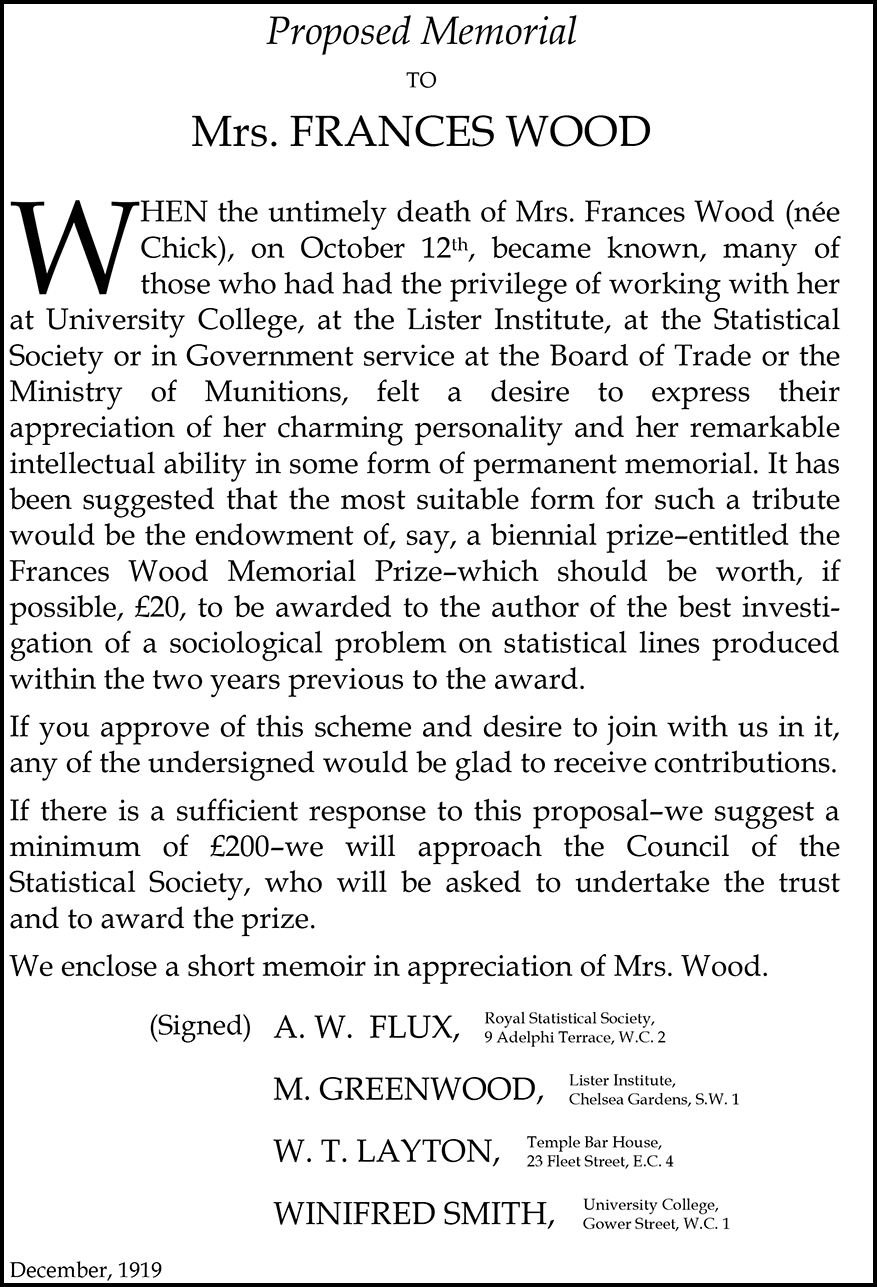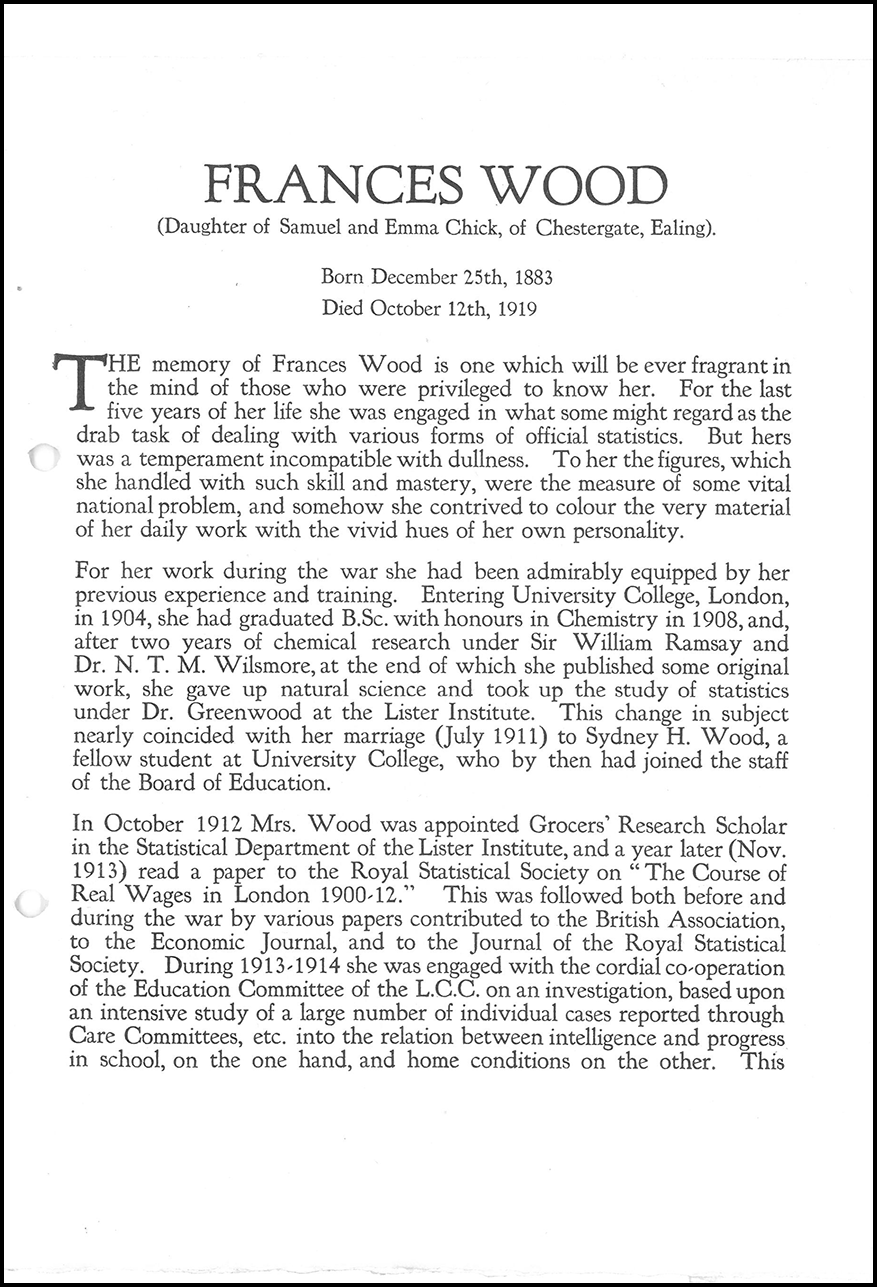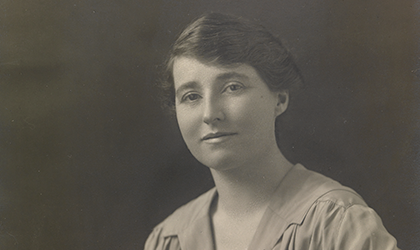
Each year at its conference the Royal Statistical Society (RSS) awards prizes to distinguished individuals for their service to statistics. The prizes include several named medals, each dedicated to a particular aspect of statistics: the Guy medals in gold (first awarded in 1892), silver (1893) and bronze (1936); and the Chambers (1977), Greenfield (1991), Bradford Hill (1994), West (2002) and Howard medals (2015). This year a new name joins the list: the Wood medal, awarded for excellent contributions to economic or social statistics.
The prize commemorates the distinguished though littleknown statistician Frances Wood, who died prematurely in 1919 aged just 35. The Frances Wood Memorial Prize was set up soon afterwards, and was offered “for the best investigation of any problem dealing with the economic or social conditions of the wage-earning classes”. The first recipient in 1921 was Winifred Mackenzie, who won £30 for her paper “Changes in the standard of living of the working classes in the United Kingdom between 1860–1914”.
The prize continued to be awarded every few years for the next 60 years, and I was very happy to win it in 1976. I spent my prize money on the three-volume set of Kendall and Stuart’s Advanced Theory of Statistics (third edition), which still sits well-thumbed on my shelf. However, the prize itself was awarded just once more, in 1980, as there were no submissions in 1982 and the prize lapsed.
The RSS Honours Committee recently noted the absence of an award covering economic and social statistics, and decided to resurrect the Frances Wood Prize as the Wood medal. This, however, posed a practical problem: what design to use for the medal? Following the example of the other medals, an obvious choice would be Frances’s effigy, but no one knew anything about her, least of all what she looked like. The secretary of the Committee emailed the members (including me) seeking guidance, and her email intrigued me. Despite my having won the prize I had never known anything about Frances Wood, so here was an opportunity: I could research her life and at the same time procure a suitable photograph for the medal design.
Frances Chick: family life
It turns out that her life was by any account remarkable. She was born on Christmas Day 1883, the sixth of seven girls, to Samuel Chick, a prosperous lace dealer and property developer, and his wife Emma (née Hooley). Amazingly, five of the seven Chick girls went on to have distinguished careers at a time when professional opportunities for women were extremely limited. (There were also three boys in the family whose life stories were unremarkable.)
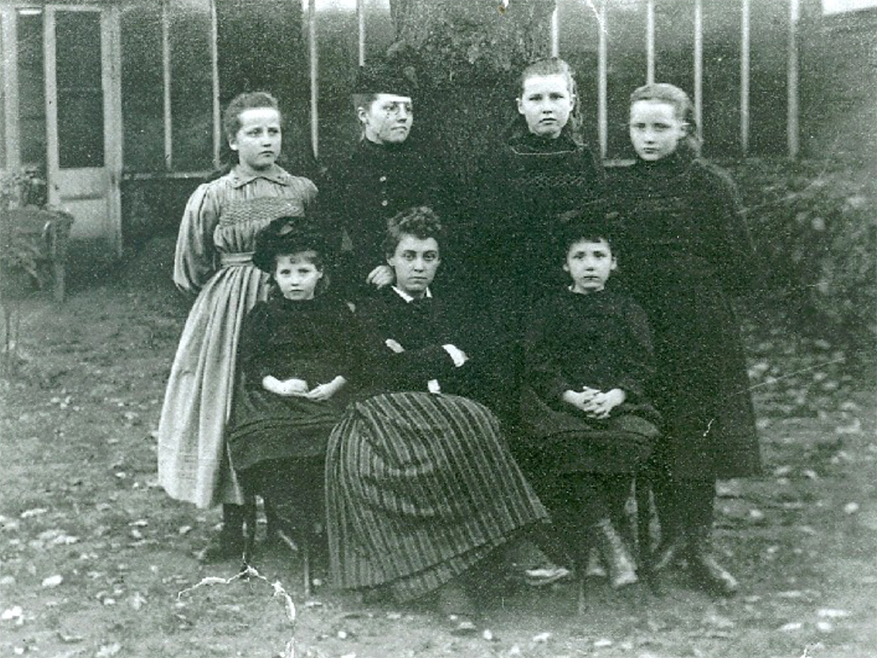
ABOVE Frances Chick, aged 5 (front left).
The sisters all went to Notting Hill High School, a girls’ school that had opened only recently but was already one of the best in the country (whether for boys or girls), with a strong science focus. Frances Chick was there from 1897 to 1903, achieving distinction both in and outside the classroom: she was pupil librarian, captain of the games club, president of the debating society, secretary of the swimming club and captain of hockey. On leaving Notting Hill High School she went up to University College London (UCL) in 1904 and graduated in 1908 with a second class honours degree in chemistry.
Four of her sisters also graduated from university: Edith (botany), Harriette (chemistry and bacteriology) and Elsie (languages) at UCL, and Dorothy (medicine) at Newnham College, Cambridge. To put this in context, UCL had only started awarding degrees to women in 1878, while Cambridge first allowed women to sit the tripos (examinations to qualify for an undergraduate degree) in 1881, awarding degrees only in 1948. For women to have a university qualification at all at that time was unusual; to have five in one family was extraordinary.
Their later careers were equally exceptional. Edith became a research botanist and married the eminent botanist Arthur (later Sir Arthur) Tansley, who went on to found the science of ecology; she bore him three daughters and lived to 101. Harriette (later Dame Harriette) became a microbiologist and biochemist, and her work on the B vitamins and the deficiency diseases beriberi, scurvy, rickets and pellagra made her one of the most important nutritionists of the twentieth century; she lived to 102. Elsie married Frederick Blackman, an eminent plant biochemist, and both Tansley and Blackman became professors (at Oxford and Cambridge, respectively) and Fellows of the Royal Society; Elsie had a son and lived to 85. Dorothy, the youngest sister, trained in surgery at the Royal Free Hospital, saw service in the First World War with the first hospital unit in Serbia, and died of influenza in 1919 aged just 31.
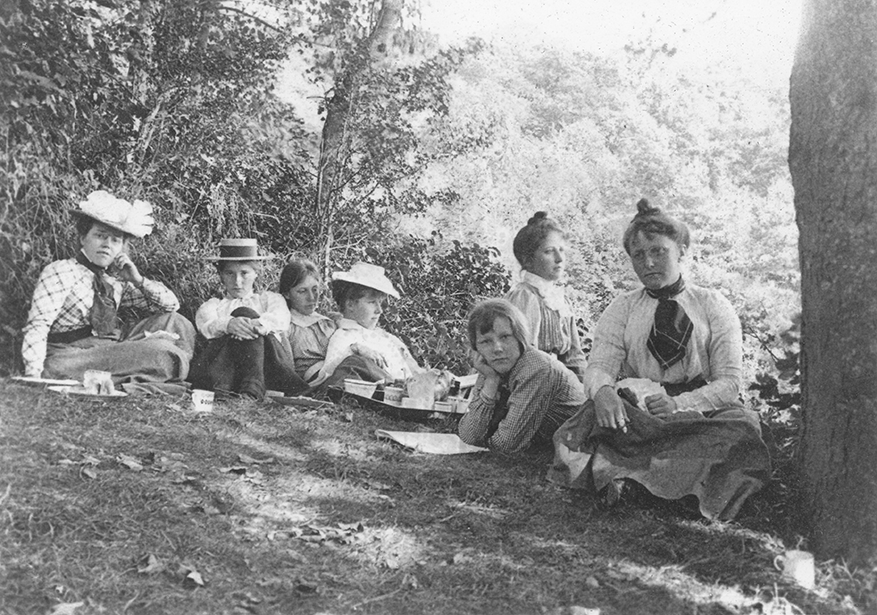
ABOVE The Chick sisters in 1902; Frances is second left.
Returning to Frances, she left UCL to take up a post as research chemist at the Lister Institute of Preventive Medicine (where Harriette was working). During 1908–12 she published three first-author papers, of which two, jointly with Norman Wilsmore of UCL on the chemistry of acetylketen, were subsequently cited over 40 times. However, it was during this period that she had what appeared to be a Damascene conversion, because by 1911 she was recorded as working fulltime in medical statistics.
In 1910 the Lister Institute had recruited the medical statistician Dr Major Greenwood (1880–1949) to form a statistics department there (he went on to become the first professor of epidemiology and vital statistics at the London School of Hygiene and Tropical Medicine, Fellow of the Royal Society, President of the RSS and recipient of the Guy medal in gold). As part of his duties at the Lister he gave a series of statistics lectures, which Frances attended, and through them her future career was set. In 1911–12 she also took courses at UCL on hygiene and eugenics.
In October 1912 she was appointed Grocers’ Research Scholar in the Lister statistics department, a post she retained until the First World War in 1914, when she was seconded to the Board of Trade. Later in the war she transferred to the Ministry of Munitions, and remained there until her resignation in March 1919.
In 1911 she had married Sydney Wood, an inspector at the Board of Education, and her resignation in 1919 was on account of her pregnancy. She gave birth to a daughter, Barbara, in September that year, but died just 12 days later from septicaemia following caesarean section. Barbara survived, and later went to Notting Hill and Ealing High School and Newnham College, Cambridge. She married Arthur Cornford and had four sons, and died in 2009 aged 90.
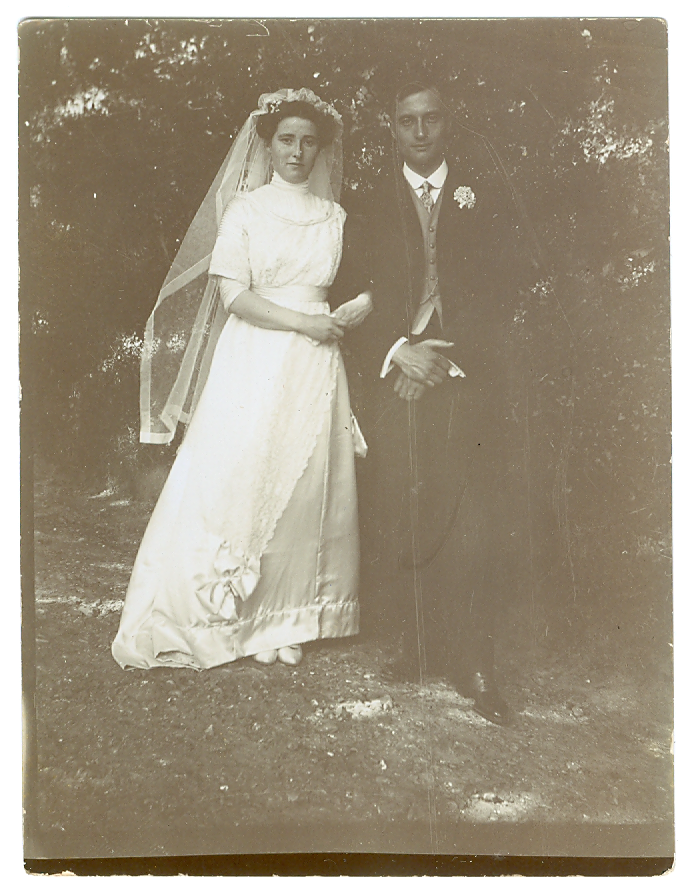
ABOVE Wedding portrait of Frances and Sydney Wood, 1911.
Frances Wood: medical statistician
Frances Wood’s statistical career, though brief, was meteoric. On 1 February 1913 she was elected Fellow of the RSS (sadly the names of her proposer and seconder have been lost). That same year she published two single-author papers, one of them read to the Society and published in its Journal (JRSS): “The course of real wages in London, 1900–12”. Its 55 pages documented in detail how the index numbers used by the Board of Trade to measure changes over time in wages, retail prices and rent were not up to the task. In the discussion following her paper, Greenwood proposed the vote of thanks, Miss Collet seconded, and five other fellows spoke. Her second 1913 paper, in the Economic Journal, expanded on the theme: “The construction of index numbers to show changes in the price of the principal articles of food for the working classes”. She returned to this topic in a 1916 JRSS paper: “The increase in the cost of food for different classes of society since the outbreak of war”. It emphasised how rising food prices could be accommodated by the middle classes simply by changing the make-up and/or quality of their diet, whereas the working classes had no such flexibility. As she succinctly put it: “It is thus perfectly clear that by far the biggest increase in the cost of food has, during the past two years, fallen upon the class least able to bear it.”
| Finding photos of Frances The task of finding pictures of Frances from over 100 years ago was made easier by the work of Margaret Tomlinson, Edith Chick’s second daughter, who catalogued the extensive Chick family archive, and whose book, Three Generations in the Honiton Lace Trade, described the Chick dynasty in some detail. The Branscombe Project, which was based in the East Devon village where Samuel Chick’s family grew up, made some of this information available on the web, which led me to it. As a result, several pictures of Frances were identified and passed to the medal designer. |
In 1913–14 Frances Wood started a project to investigate the correlation between home conditions and the mental development of children in elementary schools. She had collected data from the schools and started the analysis, but the First World War intervened and she was unable to complete it.
Also in 1914 Frances published three papers with Greenwood. The first related to cancer mortality: “On changes in the recorded mortality from cancer and their possible interpretation”. Published in the Proceedings of the Royal Society of Medicine, it asked if there was truth in the common view that cancer was on the increase, and concluded broadly that there was, though recognising the methodological difficulties that the question raised. A second paper, in the Journal of Hygiene, “The relation between the cancer and diabetes death-rates”, similarly explored methods for comparing cause-specific mortality rates, notably for cancer and diabetes whose rates were highly correlated. These two papers relied on argument backed up with tables of data to make their case, whereas the third paper of 1914, “A study of index correlations” by Brown, Greenwood and Wood in JRSS, involved considerable algebra to formalise the question of the correlation between mortality rates.
By 1915 Frances was working as a special investigator of employment statistics at the Board of Trade, where her statistical abilities soon won recognition. In that same year she was elected to the Council of the RSS as its first female member, and in 1917 she joined the RSS Executive Committee – again a first.
In October 1916 she transferred to the Central Statistical Department of the Ministry of Munitions, under Greenwood, with the job title of Section Director in charge of Special Statistical Investigations. There is no official word about her duties there, but Miss Phyllis Rule, a secretary in the Ministry, wrote a diary about a visit with “her chief” to Paris in August 1918. Her chief was Frances, whom she described as “a very charming and clever woman, who was personal assistant to the Head of the Department” (i.e. Greenwood). The visit, which lasted three months, arose because “in July 1918, when America came into the War, and all resources were pooled, a Mission was formed, representing the Allies, and went to Paris”. Miss Rule’s work was “chiefly statistical, and included very secret information for the War Office, concerning contracts for arms and ammunition”. It was presumably on the strength of this work that Frances was awarded the MBE in June 1917, with the citation “for services in connection with the war”, and in 1918 she was promoted to OBE.
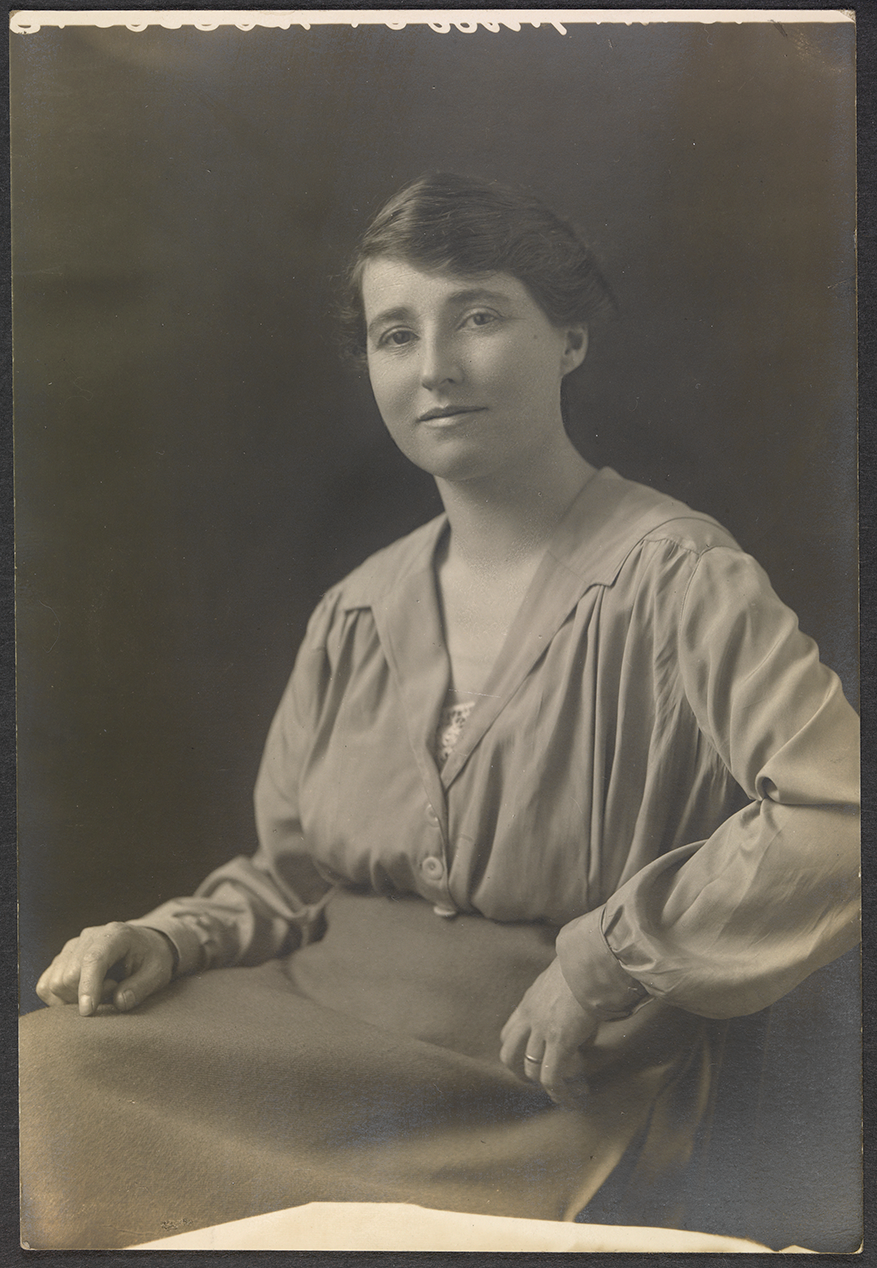
ABOVE Mrs Frances Wood OBE MBE BSc FSS, Board of Trade and Ministry of Munitions. ©IWM (WWC D8-5-415).
Her career extended beyond her death, with the appearance in 1920 of a paper by Brown, Greenwood and “the late Frances Wood OBE BSc” on “The fertility of the English middle classes: a statistical study”. Published in the Eugenics Review, it described unfinished work from 1915 about the impact of a college education on middle-class fertility. Thus it addressed a key question of the day as to whether middle-class fertility was sufficient to maintain numbers. The paper ran to 54 pages, and contained 50 tables and many regression equations relating fertility to age and duration of marriage in college and non-college women. The conclusion was that college education did not materially impact on fertility.
The data collected by Frances in 1913–14 on home conditions and the intelligence of school children also appeared posthumously. They were analysed and published in a Medical Research Council special report by Dr Leon Isserlis in 1923 “from data collected by the late Mrs Frances Wood BSc”. The paper was unusual at that time in using partial correlation to adjust for age, and its conclusion was that intelligence and economic status were indeed positively correlated.
The legacy
Frances Wood was a trail-blazer for women in statistics. Greenwood’s Lister Institute statistics department, founded in 1910, is generally recognised as the first department of medical statistics, with him the first medical statistician. It seems reasonable on this basis to credit Frances with the title of first female medical statistician. To this should be added the first woman on RSS Council and the first woman on the RSS Executive Committee.
Frances Wood was clearly well thought of during her lifetime, and this became even clearer upon her death. Her obituary appeared in JRSS in January 1920. Written by Greenwood, it demonstrated his fondness for her and his admiration of her statistical gifts.
I venture the opinion that in Frances Wood we have lost one of the most promising investigators of our time. … If faith in the statistical method as an intellectual instrument, skill in its manipulation, confidence never degenerating into rashness, patience never hardening into stolidity are the characteristics of a great investigator, Frances Wood was sealed of the tribe.
Other authors expressed their sadness at her death. In March 1920 Mr Birkett read a paper to the Society entitled “The iron and steel trades during the war”, which began:
There is one name which I must mention here: that of my colleague, Mrs. Frances Wood, with whom I had the privilege of working for nearly five years. … I cannot let this occasion pass without an expression of my appreciation of the loss sustained by the Society in the premature death of the first lady member of its Executive Committee.
In October 1920 the British Medical Journal published an anonymous editorial on the 1920 Eugenics Review article by Brown, Greenwood and Wood, saying:
The bulk of the paper was written some years ago, and the lamented death of Mrs. Frances Wood, which deprived statistical science of a brilliant student, … precluded further extension of the analysis.
The RSS annual report in 1920 included a fulsome tribute to Frances (note the titles of the other Council members mentioned).
The death roll of the past session is a heavy one, and not in numbers alone, for it includes the names of Earl Brassey, a vice-president, and of Sir Henry Burdett, Sir Richard Crawford, Sir John Glover, and Mrs. Frances Wood, O.B.E., all past members of the Council and contributors to the Society’s proceedings. Mrs. Wood was the first woman member of the Council, to which she was elected in 1915. Her early death is a cause of the deepest regret to her colleagues, and is a loss to the Society and to the cause of social science which cannot easily be measured. The Council’s appreciation of her work and personality was expressed in the following resolution:–
“The Council of the Royal Statistical Society desire to express their sense of the loss to statistical science occasioned by the untimely death of their valued colleague, Mrs. Frances Wood, and their personal sorrow at being deprived of her cooperation. The Council had formed a high opinion of Mrs. Wood’s scientific work, had noted with pleasure the official recognition it earned, and tender to Mrs. Wood’s relations an expression of their deepest sympathy.”
It was just two months after her death that a note of a “Proposed Memorial to Mrs. Frances Wood” was circulated. It invited those who had worked with her at UCL, at the Lister, in the RSS or government, and who “felt a desire to express their appreciation of her charming personality and her remarkable intellectual ability”, to contribute to the Frances Wood Memorial Prize. The hope was to raise £200, but in the event the call raised £300 (worth £14 000 now) and led to the biennial essay prize being established.
(1) A reproduction, by the author, of the notice of Proposed Memorial to Mrs. Frances Wood. (2) A scanned copy of the original obituary notice, which accompanied the notice of Proposed Memorial. Click to view both documents in full.
Nowadays the numbers of women and men in statistics are close to parity. Frances Wood’s life reminds us how the role of women in statistics, science and society has changed dramatically since the early twentieth century. Her memorial prize was established to commemorate her remarkable life, which it has clearly done, but it has done so much more in highlighting the advances that women have made in the past 100 years.
Acknowledgements
I am very grateful to Barbara Bender, Liz Broekmann, Janet Foster, Tristram Hodgkinson, Tony Johnson and Caroline Martin for their help with the project.
About the author
Tim Cole has been professor of medical statistics at UCL Institute of Child Health since 1999. He originally studied engineering at Cambridge and statistics at Oxford, and has been employed by the Medical Research Council (MRC) for his entire career since 1970, working first at the MRC Pneumoconiosis Research Unit in South Wales and then from 1975 at the MRC Dunn Nutrition Unit in Cambridge. Since 1999 he has been an external scientific staff member with the MRC.

